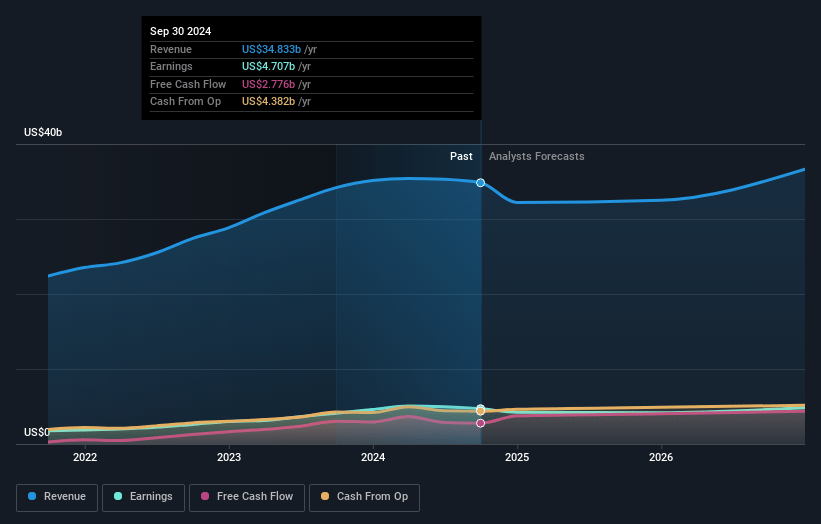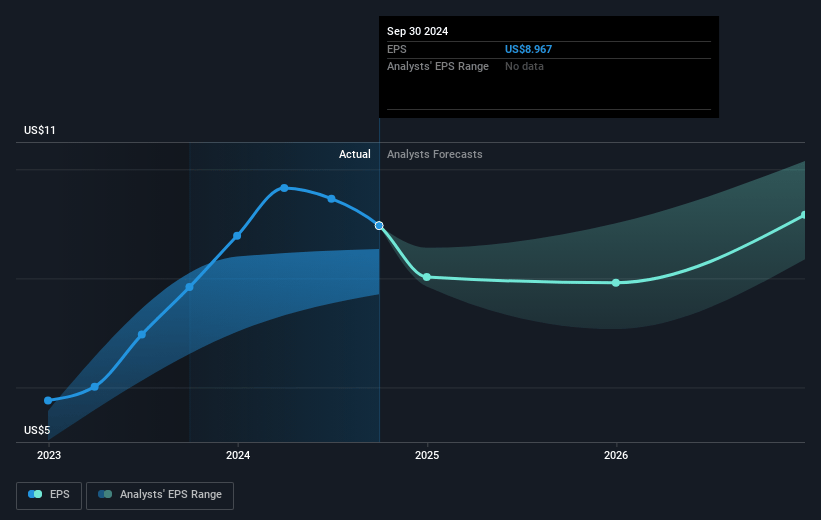Key Takeaways
- PACCAR is well-positioned for international growth and market expansion due to rising truck market shares and efficient designs.
- Strategic investments in technology and R&D aim to boost operational efficiency, enhancing competitiveness and future profitability.
- Volatile exchange rates, European market pressures, regulatory changes, and medium-duty segment downturn may challenge PACCAR's pricing, margins, and revenue growth.
Catalysts
About PACCAR- Designs, manufactures, and distributes light, medium, and heavy-duty commercial trucks in the United States, Canada, Europe, Mexico, South America, Australia, and internationally.
- PACCAR is poised to grow its revenues due to increased market share in Class 8 truck retail sales, with Kenworth and Peterbilt's share rising to 30.7%. This gain establishes a strong presence in a sector expected to see a strengthening market in 2025.
- With expansions in Brazil, Mexico, and the Andean region, along with increased DAF market share in Europe, PACCAR is positioned for international revenue growth, leveraging its innovative and efficient truck designs.
- Investments in manufacturing capacity and advanced technologies such as clean diesel, alternative fuel engines, and battery electric powertrains are expected to enhance the company's competitive edge, potentially boosting net margins through increased operational efficiency.
- The company's focus on PACCAR Parts, which has shown resilience and profitability through different market cycles, is set to drive earnings growth as part sales are projected to increase by 2% to 4% in 2025.
- Strategic investments in capital projects and research and development, amounting to more than $1 billion this year, are expected to support long-term growth and innovation, thereby driving future earnings and enhancing return on invested capital.
PACCAR Future Earnings and Revenue Growth
Assumptions
How have these above catalysts been quantified?- This narrative explores a more optimistic perspective on PACCAR compared to the consensus, based on a Fair Value that aligns with the bullish cohort of analysts.
- The bullish analysts are assuming PACCAR's revenue will grow by 3.2% annually over the next 3 years.
- The bullish analysts assume that profit margins will increase from 12.4% today to 12.7% in 3 years time.
- The bullish analysts expect earnings to reach $4.7 billion (and earnings per share of $9.15) by about April 2028, up from $4.2 billion today. The analysts are largely in agreement about this estimate.
- In order for the above numbers to justify the price target of the more bullish analyst cohort, the company would need to trade at a PE ratio of 17.2x on those 2028 earnings, up from 10.9x today. This future PE is lower than the current PE for the US Machinery industry at 17.9x.
- Analysts expect the number of shares outstanding to grow by 0.13% per year for the next 3 years.
- To value all of this in today's terms, we will use a discount rate of 7.77%, as per the Simply Wall St company report.
PACCAR Future Earnings Per Share Growth
Risks
What could happen that would invalidate this narrative?- The volatility and potential strengthening of the U.S. dollar, which has previously led to a $20 million negative impact on net income, could continue to affect PACCAR's earnings if exchange rates remain unfavorable.
- PACCAR may face pressure on their pricing and operating margins in Europe due to a significant market downturn, especially in Central and Eastern European countries like Poland and Lithuania, which saw declines impacting DAF's market share and potentially future revenue growth in the region.
- If regulatory changes on emission standards and powertrains, such as shifts in 2027 compliance requirements or differing state regulations, occur unpredictably, it could lead to increased production costs or sales disruptions, affecting net margins.
- The used truck market's stability is essential for PACCAR Financial's performance, but future variability in secondhand truck demand could impact asset values and therefore the company's financial services earnings.
- The mention of a potential downturn in the medium-duty segment, which is expected to return to historical levels after robust performance, could impact sales volumes and revenues if not offset by growth in other areas or segments.
Valuation
How have all the factors above been brought together to estimate a fair value?- The assumed bullish price target for PACCAR is $122.91, which represents one standard deviation above the consensus price target of $108.55. This valuation is based on what can be assumed as the expectations of PACCAR's future earnings growth, profit margins and other risk factors from analysts on the bullish end of the spectrum.
- However, there is a degree of disagreement amongst analysts, with the most bullish reporting a price target of $134.0, and the most bearish reporting a price target of just $78.0.
- In order for you to agree with the bullish analysts, you'd need to believe that by 2028, revenues will be $37.0 billion, earnings will come to $4.7 billion, and it would be trading on a PE ratio of 17.2x, assuming you use a discount rate of 7.8%.
- Given the current share price of $86.4, the bullish analyst price target of $122.91 is 29.7% higher.
- We always encourage you to reach your own conclusions though. So sense check these analyst numbers against your own assumptions and expectations based on your understanding of the business and what you believe is probable.
How well do narratives help inform your perspective?
Disclaimer
AnalystHighTarget is an employee of Simply Wall St, but has written this narrative in their capacity as an individual investor. AnalystHighTarget holds no position in NasdaqGS:PCAR. Simply Wall St has no position in the company(s) mentioned. Simply Wall St may provide the securities issuer or related entities with website advertising services for a fee, on an arm's length basis. These relationships have no impact on the way we conduct our business, the content we host, or how our content is served to users. This narrative is general in nature and explores scenarios and estimates created by the author. The narrative does not reflect the opinions of Simply Wall St, and the views expressed are the opinion of the author alone, acting on their own behalf. These scenarios are not indicative of the company's future performance and are exploratory in the ideas they cover. The fair value estimate's are estimations only, and does not constitute a recommendation to buy or sell any stock, and they do not take account of your objectives, or your financial situation. Note that the author's analysis may not factor in the latest price-sensitive company announcements or qualitative material.







